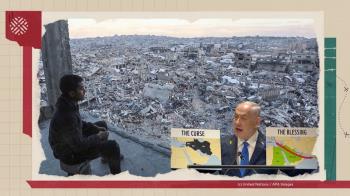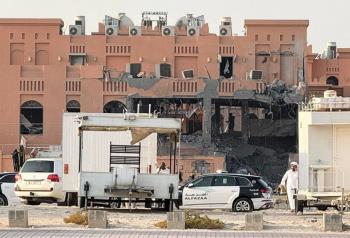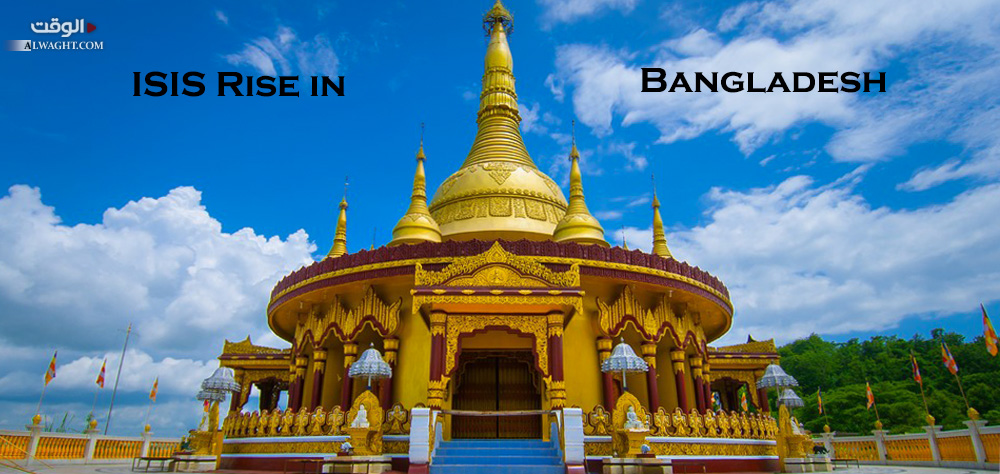Alwaght- By taking a multi-faceted and multi-layered look at the violent nature of jihadi-takfiri movements in Bangladesh, including ISIS’ branch there, which has recently taken responsibility for a couple of terrorist attacks in the country, it becomes clear that such a behavior essentially has roots in different political, cultural, and security principles and stimulations, and developed in a highly diversified background.
In first view, the existence philosophy and the process of evolution of nature of some countries like Bangladesh, Pakistan, and others unwantedly fuel the emergence and growth of militarism and extremism in these countries.
With 90 percent of its population Sunni Muslims and only 10 percent Hindus, Bangladesh seceded from Pakistan on March 26, 1971, by an Indian support and leadership of Sheikh Mujibur Rahman. Mujibur Rahman tried to establish a secular system in this majorly Muslim country, but he was assassinated in 1975. After Sheikh Mujibur Rahman, General Ziaur Rahman took over the power, but he was, too, assassinated in 1981. After him, his wife Khaleda Zia founded Bangladesh Nationalist Party and became prime minister of the country. Following her, Hasina Wazed, the daughter of Sheikh Mujibur Rahman, took over post of prime minister from 1996 to 2001. Wazed again in 2009 became prime minister as her party won majority in the Bangladeshi parliament.
The bases of political power and violent transition of power between the ruling elites of this Muslim country, which mostly are accompanied by military coups and India’s interventions, have granted increasing power to the Islamic groups which are recognized as forces opposing such a situation.
In addition to these structural flaws in Bangladesh’s political system which fan extremism boost in the country, the following points could help get a better understanding of rise of ISIS terrorist organization in Bangladesh:
1. Despite the fact that activity in Muslim regions of southern and southeastern Asia is not priority for ISIS in its announced policy, these regions historically and due to distance from Muslim world's developments centers in the time of threat have always been safe havens for growth and persistence of the radical Islamist movements.
In early April, Abu Ibrahim al-Hanif, the chief of ISIS in Bangladesh, in an interview told Dabiq, an online magazine run by ISIS, that Bengal in eastern India was of strategic significance for the terrorist group. He added that ISIS presence in Bangladesh was first step to liberate Myanmar. Al-Hanif continued that the Bangladesh-based ISIS forces could launch attacks on India in association with the Islamist forces from different places. He argued that Hindus of Bangladesh and India declared war against the Muslims. He also claimed that strong bases for ISIS in the region could facilitate it to carry out partisan assaults simultaneously in western and eastern India with a backing from Indian members of the group in a bid to “fully liberate the region from the grasp of the pagans.”
2. The political rifts and dynamism in Bangladesh to a large extent provide the grounds and motives for periodic extremism in the country. Having in mind that the anti-Bangladeshi government opposition groups use the potentials of the religious groups like Bangladesh Jamaat-e-Islami or secretly support some of armed groups active in the country, sometimes political scuffles lead to violence caused by the religious extremists. Hasina Wazed, the current prime minister of Bangladesh, amid political rivalry and rifts repeatedly accused the two parties of Bangladesh Nationalist Party and Bangladesh Jamaat-e-Islami of orchestrating terrorist attacks in order to damage the Bangladeshi government. In 2015, the opposition party of Bangladesh led by Khaleda Zia arranged massive anti-government rallies. Moving to put the demonstrations down, the Bangladeshi police forces opened fire, killing at least 120 protesters. The government claimed that the sabotage activities were directly led by some senior leaders of Jamaat-e-Islami and the Islamic Student Movement. It is notable that the militant groups existing in Bangladesh are organizationally weak, and only hold some ideologies in common with ISIS and Al-Qaeda.
3. If we accept the analysis that sees ISIS’ prance in southern Asia as a Pakistani project, then we must assume that ISIS’ muscle flexing in some parts of Asia, including Bangladesh, is a security maneuver organized by Islamabad against the Indian-Bangladeshi camp. Backed by India, the present Bangladeshi government has started clamping down on the Islamic groups in the country. It also works with India to contain Pakistan’s moves on the Bangladeshi borders. It appears that Islamabad to confront these moves by the other side always tried, through influence of Islamic groups in Bangladesh and strengthening Al-Qaeda in the Indian Subcontinent (AQIS) as well as ISIS, to develop a kind of security-strategic equation against India while the latter has always sought to get a toehold in Afghanistan. Execution of Motiur Rahman Nizami, the former leader of Bangladesh Jamaat-e-Islami, in May 2016 also in some way sent the diplomatic relations between Bangladesh and Pakistan chilled. In protest moves, Pakistan and Bangladesh summoned ambassadors of each other. It seems that chilled ties have triggered influence and activity of terrorist groups in Bangladesh.
4. Competition between Al-Qaeda and ISIS to expand and keep influence in Bangladesh has also helped boost of ISIS presence in the country. The Subcontinent is essentially a backyard for Al-Qaeda, and the terrorist group holds better potentials in this region for launching attacks. The defected Al-Qaeda forces which are discontent with its inactivity in the Indian Subcontinent could provide ISIS with well-trained and strong forces. Sometimes the changes and developments in the region are easily done with provocation by the ISIS’ members who come back from the Iraqi and Syrian battlefields. Ansar Al-Islam group, an affiliate of Al-Qaeda in Bangladesh, in late April claimed responsibility for assassination of two political activists in the country. In early April the same terrorist group had taken responsibility for killing a university student protesting the radical Islam in Bangladesh. At the same time, ISIS claimed responsibility for killings in Al-Qaeda areas of influence in a bid to promote itself and be able to recruit more members and so practically beat Al-Qaeda in the Subcontinent. For the first time on September 28, 2015, ISIS publicized its presence in Bangladesh. During the past five months, the terrorist group has accepted responsibility for 15 assaults conducted across the country. Al-Qaeda since 2013 collectively took responsibility of 13 terrorist attacks in Bangladesh which killed 11 people.
Accordingly, although ISIS rivalry with Al-Qaeda in Bangladesh is a major drive for expansion of terrorism in this South Asian country, it would be the most crucial hurdle ahead of evolution of activities of ISIS takfiris in Bangladesh. Al-Qaeda has strong native allies like Ansarullah or Ansar Al-Islam in Bangladesh— an alliance that could put strains on ISIS in the country.
5. Some part of violencism of the extremists in Bangladesh should be attributed to the complicated and volatile relations between the government and the Islamists in this country. The India-backed Prime Minister of Bangladesh Hasina Wazed has formed a fact-finding committee to probe into war crimes committed in 1971 during which a number of Hindus were killed. By doing so, she has in practice started a confrontation with the Islamic groups in the country. On May 10, the Bangladeshi government confirmed that it hung Motiur Rahman Nizami after he was blamed for committing war crimes during the civil war of Bangladesh in 1971. Earlier, Dhaka had hung two other Islamist leaders of Bangladesh for similar charges. By adopting this approach which is turning normal in the country's politics, the Bangladeshi government has transformed the Islamism in the Subcontinent that holds peaceful principles and essences into an unsolvable security challenge and a violent entity.
The Bangladeshi government argues that ISIS is not present in the country. The fact is that Dhaka’s denial fails to solve any problem. ISIS recruitment of Bangladeshi nationals for fight in Syria and Iraq, the terrorist group's major battlefields, is something confirmed. Beside chronic and deep-rooted political rifts in Bangladesh, the country has always been vulnerable to falling into quagmire of violence because the illiteracy and unemployment rates are high in the country. Therefore, once no moves are made against ISIS’ bridgeheads in Bangladesh, perhaps the ISIS ghost in this populous Muslim country turns into an uncontrollable monster. It appears that the Subcontinent countries have to ponder the idea of foundation of a rapid reaction force to deter the terrorist organizations in the region, as the Bangladeshi security forces have failed to display speedy and efficient reaction in their taking on of the terrorists.



























